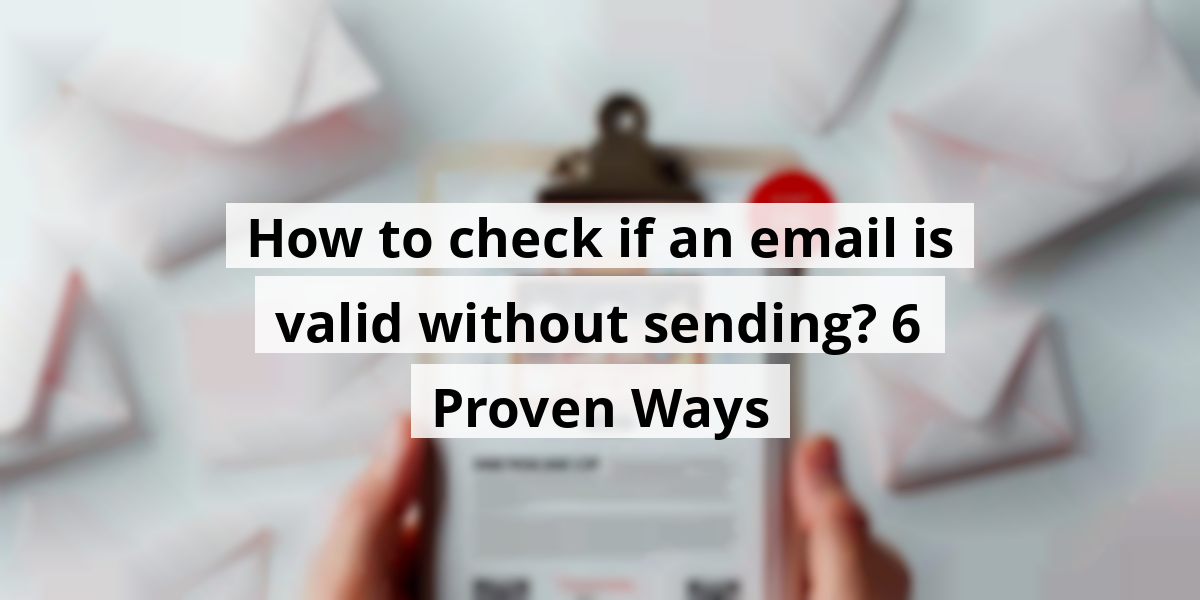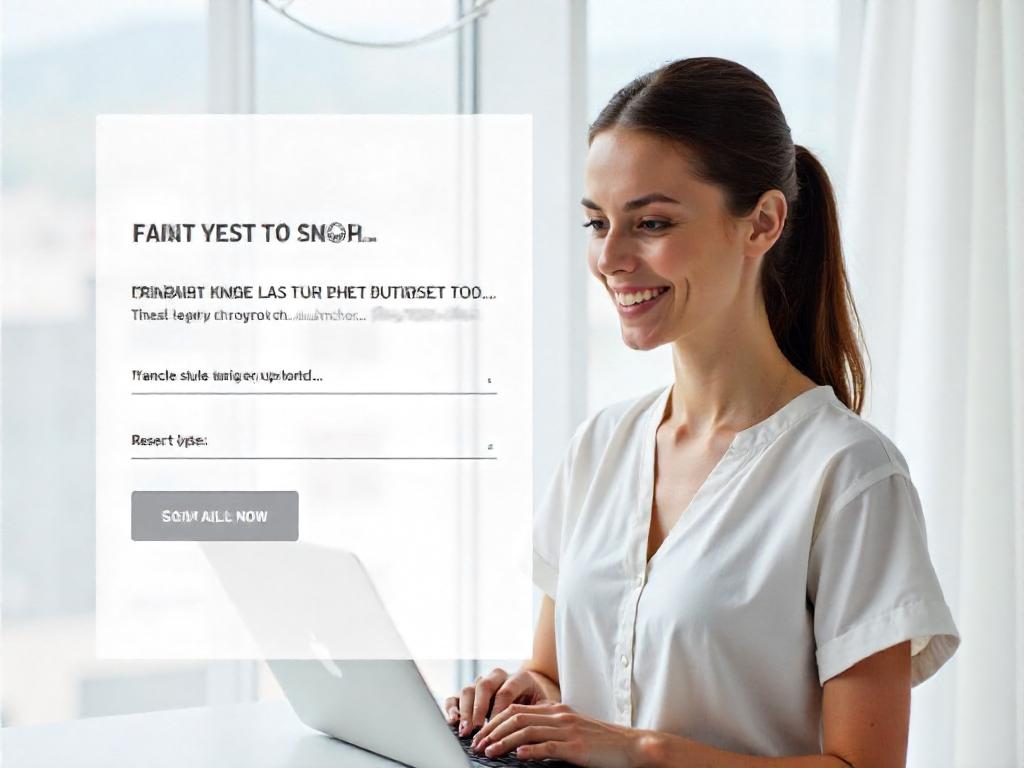 LIMITED SPOTS
All plans are 30% OFF for the first month! with the code WELCOME303
LIMITED SPOTS
All plans are 30% OFF for the first month! with the code WELCOME303

 LIMITED SPOTS
All plans are 30% OFF for the first month! with the code WELCOME303
LIMITED SPOTS
All plans are 30% OFF for the first month! with the code WELCOME303


Now we are going to talk about the nuts and bolts of checking if an email address is indeed valid. It’s like making sure your keys are in your pocket before leaving the house. You don’t want to get locked out, right?
To verify an email address, we need to start at square one: the structure. Think of it as the framework of a house; without it, everything else crumbles. We’re looking for a username, the trusty “@” symbol, and a domain name—like the three musketeers of emailing.
First off, if it’s missing any of these components, that email is about as useful as a chocolate teapot:
username + "@" symbol + domain nameLet’s light it up with some examples! If you see:
✅ john.doe@example.com ❌ john.doe.example.comIn the first one, we have all the essentials. In the second? Well, it’s like trying to order a pizza without giving an address; good luck with that!
Just like when we were kids trying to spell our names correctly, there's a specific order to follow here if we want a green light from the email gods. It’s fun to remember that many email clients are quite forgiving. They might hint at errors or suggest corrections. However, if it doesn't pass the syntax sniff test, it's out of the game.
So, here’s a quick checklist to keep in our back pocket when we’re on the hunt for valid email addresses:
We often come across email addresses that seem to flout the rules, don’t we? “peterk.john.com” might sound okay at first, but it’s like wearing socks with sandals—it raises eyebrows. Testing those addresses before sending an email helps avoid communication mishaps.
In the end, being cautious with our email list not only ensures our messages get where they belong but also helps keep our sanity intact! After all, who needs a full inbox of bounces?
Now we’re going to chat about some nifty tricks for checking if an email address is on the up and up. Spoiler alert: it’s simpler than finding your way through a corn maze.


One of the easiest methods we can use involves just hovering over an email address. Whether in Gmail or Google Sheets, this little trick can shine a light on whether that email is the real deal. For added accuracy, using an email validator helps confirm the address is valid and reduces the risk of sending messages to inactive or incorrect emails.
When we hover over the address, we may uncover details like the person’s name or even their profile picture. If that’s not enough to pique our interest, we don’t know what is!
Let’s run through the steps for checking an email address in Gmail:
If it’s a valid email, voilà! Their full name and profile picture magically appear, almost like spotting a celebrity in a coffee shop.
For those spreadsheet aficionados among us, here’s how to check validity in Google Sheets:
Here too, if the address works, you’ll see the lead’s full name and their smiling mug shot pop up, giving us the confidence we need to hit send.
What’s brilliant about these methods is that they save us from awkward situations later on. No one wants to send an email to “JohnSmith123” and realize it bounces back harder than a rubber ball! Plus, it keeps our personal email etiquette in check, which is always a bonus.
Staying on top of our email game isn’t just about being tech-savvy. It’s about etiquette too. Who knew some light hovering could prevent social mishaps? Just like how we wouldn't walk into a party wearing socks with sandals—email validation keeps us looking sharp.
In these days of bustling inboxes and social media mixing with work, having reliable email contacts can make all the difference between a smooth communication and a cascade of confusion. So, let’s keep those hover skills sharp!
Now we are going to talk about a practical way to validate an email address using a simple Google search. Trust us; it’s quicker than making a cup of instant coffee—and way less messy!

Have you ever received an email from someone that made you raise an eyebrow? We've all been there. It's like shopping online—sometimes, the most enticing offers are bait on a hook trying to reel us in!
The good news is that checking if an email address is legit is a breeze. Just pop that email into Google Search. Think of it as digital sleuthing. When we’ve done this, we usually just take a breath and hit “search.”
If the email pops up on social media profiles or various online pages, it’s likely in use. This isn’t foolproof, but it sure helps cut down on the guesswork.
Here are a few steps to help streamline the process:
Google is like our trusty sidekick in this quest! But it's always good to keep a few other tricks up our sleeves. Just in case you need to go beyond a blissful search.
| Step | Action |
|---|---|
| 1 | Enter the email in Google. |
| 2 | Scan for social media links. |
| 3 | Check forums and discussion boards. |
| 4 | Verify context and connections. |
Let’s not forget: the internet is a bit like a jungle; some creatures are genuine, while others might try to snag us with their clever ruses. The next time we consider reaching out to someone based on an email address, a quick search can save us from potential headaches down the road.
Concluding this fun expedition, validating email addresses can be a piece of cake with just a search away. Cheers to trusting our online interactions a bit more!
Now we are going to talk about how we can spot those email domains that have been around for a while. It's quite a useful skill in our digital toolkit. Knowing how to check the age of a domain can save us from a heap of trouble.
We’ve all been there—opening an email that feels fishy, like that email from a "prince" offering us a fortune. More often than not, those sketchy emails come from brands with shiny new domains. In our experience, established domains generally mean a reputable business. So, next time we’re curious if a company is worth our time, it’s worth checking how long that domain has been around. Here are some reasons why we should consider domain age:
Tools like Small SEO Tools are fantastic for checking domain age. It’s as easy as pie; just plop the site’s URL in, and voila! We’ll have our answer faster than we can find the remote when our favorite show starts. For example, we used this checker the other day, feeling a bit like digital detectives, and discovered that a seemingly awesome tech startup was just a month old. Needless to say, we clicked “unsubscribe” faster than a cat jumps out of a bath. In short, it’s a quick and easy step we shouldn’t overlook in our sales strategies. Knowing how old a domain is can help ensure we’re going the distance with trustworthy prospects, avoiding those traps out there in the wild world of email marketing.
Now we are going to talk about a nifty little trick for ensuring your emails hit their target. Think of it as giving your emails a GPS—because nobody wants their messages lost in cyberspace!


It's like finding a needle in a haystack when you're trying to figure out whether an email address is legit or just a mirage. Picture a crowded inbox, filled with messages bouncing back like an overenthusiastic basketball. We've all been there, right? Unruly emails that seem to have a vendetta against our well-planned outreach efforts. But fret not! We can give our inboxes some TLC with a complimentary email verification tool. Many of these nifty applications let us check a number of emails without costing us a dime. Let’s dive into why this is a must-do for anyone who's ventured into the digital communication waters.
Using a free email verifier means we can confidently put our best foot forward. Recently, there have been a few buzzworthy tools that have caught everyone's attention. With winter approaching, we’d rather not freeze our outreach efforts with endless bounces! A quick story: A friend of ours launched a campaign using a questionable email list, and, well, let's just say the results were as disappointing as a soggy sandwich. A few days lost to bounce-backs had us both rolling our eyes. Since then, we’ve made it our mission to verify, verify, verify! So, in the spirit of saving time and sanity, why not give email verification a whirl? You might just find those emails are not the Bermuda Triangle of communication anymore!
Next, we will look at a fantastic tool for email management that can save us more time than the yearly family holiday shopping spree.
When dealing with massive email lists, we all know the struggle: falling down the rabbit hole of undeliverable emails. Enter lemlist's Email Finder and Verifier. It's like having a digital assistant that works harder than our various remote controls during movie night!
Imagine getting a whopping 80% of valid emails while other tools struggle to scrape together just 15% to 60%. Talk about being overachievers! It's like being on a scavenger hunt where the prize is actually something useful.
This tool doesn’t just verify; it can enrich our data quicker than it takes to say "email marketing," automatically filling in gaps with verified emails, phone numbers, and even LinkedIn details. No more sending awkward "Did my last email disappear into the void?" follow-ups!
Using lemlist, we can:
Got a bunch of emails to check? No problem! The waterfall lead enrichment method promises to find and verify addresses—think of it as the email equivalent of sending our friend into the fridge to fetch snacks.
Typically, this feature taps into several reputable data sources, boosting valid email finds by a healthy 40-55%. Quite a relief when juggling multiple tools could leave us feeling like a circus performer!
First off, did you know verifying emails is as easy as clicking a button? Yep, we can do this during the setup process after importing our lead lists. It’s almost too easy—a bit like making toast, but with less chance of burning the edges!
Steps to follow:
For each lead, we get a thorough rundown:
If there's more info, like phone numbers or job titles, lemlist saves that too. Less time hunting for details means more time for relaxation. Just don’t forget, you can occasionally sprinkle in those extra details as you collect them.
To keep it interesting, let’s break down the costs:
All new users start off with a 100 Free Credits—perfect to get the ball rolling. They even reset monthly based on your plan. Isn't that just the cherry on top?
If you’re feeling pro, purchases for additional credits are on hand for just $0.01 each, rolling over to next month. It's like finding cash tucked away in the couch cushions. Who doesn't love that?
Now we're going to talk about some handy tools for ensuring your email list is as fresh as a daisy and ready to deliver. After all, we’ve all sent an email to a “ghost” account, right? You know, the kind with no one on the other end, just tumbleweeds blowing through the inbox? That’s why it helps to sniff out those bad addresses before hitting “Send.” So, let’s dig into some reliable tools that’ll give your email validation efforts a boost and save you from the embarrassment of those bounces!

| Tool | Price per Credit | Initial Cost |
|---|---|---|
| Clearout | $0.007 | $7 for 1000 credits |
| Bouncer | $0.008 | Pay-as-you-go |
| NeverBounce | $0.007 | Pay-as-you-go |
| Emailable | $0.00646 | Pay-as-you-go |
| TrueMail | $34 for 5000 credits | $34 |
| ZeroBounce | $0.00225 | Pay-as-you-go |
| DeBounce | $0.002 | Pay-as-you-go |
Just upload that email list you’ve been hoarding, and these tools will churn out a CSV report for you, clearly marking which addresses are *about as useful as a screen door on a submarine*. With these options, the chances of your emails landing in the spooky void are much lower. So grab your toolkit and keep those unwanted emails at bay!
Now we are going to talk about making sure our emails don't land in that dreaded spam folder. It’s like trying to find a needle in a haystack—always a bit of a challenge! So, let’s jump into our 11-step formula for better email deliverability and avoid the spam trap like it’s last week’s leftovers.


Next, we are going to chat about a topic that often leaves folks scratching their heads: email verification. You know, that awkward moment when you realize half your emails are bouncing back like a rubber ball? Well, let’s sort through that mess, shall we?
Imagine sending a heartfelt email only for it to vanish into the void like a message in a bottle. Your bounce rate skyrockets, and that means your emails are more likely to filter straight into the spam folder. Nobody wants that, right?
Not to worry, we’ve all been there! Use tools like free email verifiers or a quick Google search. Analyzing the domain age can help you spot a scammy address faster than spotting a green light on a traffic signal.
They can be quite handy for basic checks, no doubt about it! However, you might want to pony up for premium tools if you need precision, like relying on a compass instead of doing the trust fall with your buddy.
It’s like checking the fridge for expired milk! A good rule of thumb—always verify before campaigns and whenever adding fresh contacts. That way, you'll keep your bounce rate low and your sanity intact.
You bet! Verified addresses lead to better deliverability, like adding extra maple syrup on your pancakes—everyone wins! More emails delivered equals more chances for that sweet return on investment.
Think of bounce rate as your email's trip to the Bermuda Triangle; it’s the percentage of emails that never make it. Deliverability rate, on the other hand, reflects how many actually land in inboxes, which is where all the action happens.
You sure can! Grab some bulk email verifier tools, like your trusty list manager. They can save precious time, fellow email warriors!
Now we are going to talk about the significance of sending emails to verified addresses. We've all been there, crafting the perfect email only for it to land in a black hole—thanks to an invalid address. Trust me, it's like throwing a birthday party and forgetting to invite the guests!

Picture this: You have your coffee, your favorite playlist is on repeat, and you’re feeling like a communication ninja. Suddenly, you hit send… only to discover that half your recipients' emails bounce back. Frustrating, isn’t it? It's enough to make anyone want to pull their hair out!
Sending emails to unverified addresses can waste precious time and resources. It's like trying to make a gourmet meal with expired ingredients; the end result is never what you hope for. The real kicker? Continually mailing invalid addresses can harm your sender reputation and push your messages straight into the spam folder.
So, how do we avoid this email disaster? Here are a few steps:
| Step | Action | Benefit |
|---|---|---|
| 1 | Use Verification Tools | Stop sending emails into the void |
| 2 | Clean Your Lists | Maintain a healthy list of contacts |
| 3 | Monitor Bounce Rates | Ensure high deliverability rates |
| 4 | Engage Your Audience | Keep them informed and connected |
To confirm an email's validity, the first step is locating your prospects’ addresses, which can feel like finding a needle in a haystack sometimes. But don’t worry; with the right tools, we can make this process smoother than a Sunday morning!
Remember, avoiding the pitfalls of unverified emails can dramatically boost your business’s communication success. So, let’s keep those inboxes clear and make sure our messages land in the right hands!

